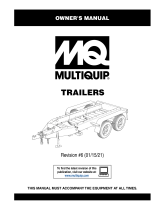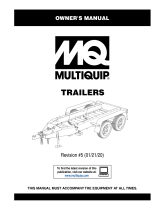
DRY PRIME PUMP — OPERATION AND PARTS MANUAL — REV. #3 (10/06/08) — PAGE 17
GENERAL INFORMATION
The Multiquip Dry Prime pump is a prime dry and prime-
assist pump that can handle dewatering, sewer bypass, and
wellpoint applications.
The Dry Prime pump uses a vacuum pump to remove the
air. This becomes important in certain applications such as
long suction hose runs or multiple suction points (such as
wellpoints). In these cases, high volumes of air enters into
the pump. Dry Prime uses direct-drive vacuum pump to
efficiently remove very large volumes of air quickly to obtain
the priming necessary for these special applications. Dry
Prime is very useful when you have to move a lot of water
fast.
Impeller
The Dry Prime impeller has a patented design to eliminate
cavitation. It is a 2-blade spiral, smooth flow, open, non-clog
impeller, designed to handle up to 3.2-inch solids. The impeller
pulls water directly into the pump from the priming tank,
reducing friction losses, and then pushes it out the volute
discharge. This design does not cause turbulence normally
found in centrifugal pumps.
Wear Plate
In conjunction with the impeller, the wear plate gives a perfect
match for great pump performance and durability. The wear
plate can be fully adjusted up to .6 inch (15mm) for wear.
Priming System
The vacuum system is innovative, simple, yet rugged and
dependable. I uses direct drive which means no belt failure
and with only one moving part, means no maintenance. It
uses liquid-ring design with a closed water system. Separate
oil bath lubrication for the seal and bearings with oil reservoir,
can run dry without damage. It operates quietly with no
pollution or unwanted discharge noise.
Float and Backflush (Priming Tank)
The priming tank float is a one-piece welded construction,
rubber valve seat, self-aligning rubber hinge. This design
increases reliability. The backflush valve allows for cleaning
of the suction strainer or wellpoint headswhile the engine is
running.
Fuel Tank
Frame and Trackbar System
Run time is up to 72 hours with the Dry Prime’s fuel tank,
good for continuous running for those long-term jobs. There
are two corner fuel drains to check condition of fuel. The
TrackBar system allows for the easy addition of jack stands,
fenders, axle, lifting bail, and other options. This allows for
fast and easy positioning of the jack stands on the job site
to fit the application, or to add subtract jack stands as
required. The removable, retractable towing tongue minimizes
storage requirements.
Volute
The pump volute has an external inspection cover to inspect
or clear the impeller. The pump shaft bearings and
mechanical seal are run in independent oil baths for low
maintenance.
LOFA Engine Control Panel
Vandal protected panel that provides engine status and shut-
downs in the event of low oil pressure, high engine heat,
and alternator belt breakage. Optional auto-start module with
floats can be added for automatic start-stop of pump engine
and pumping operation.































